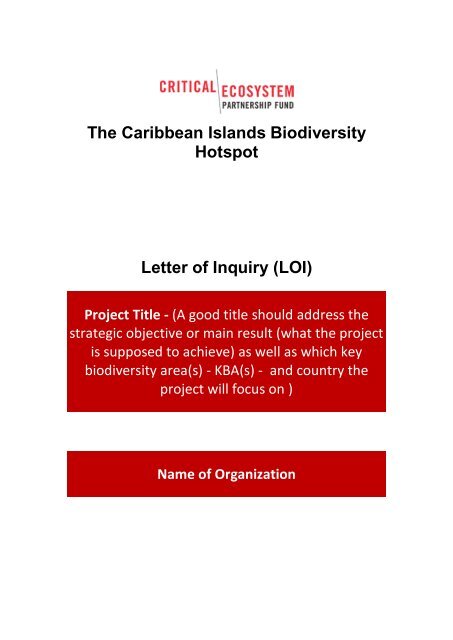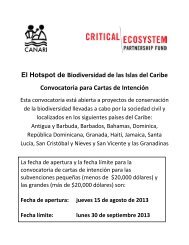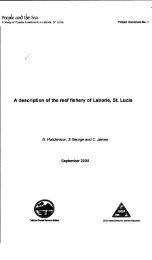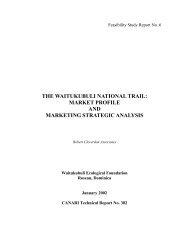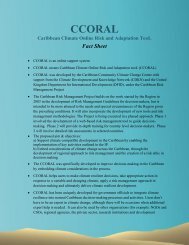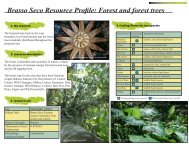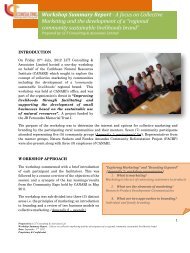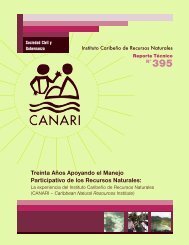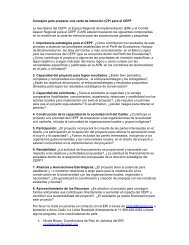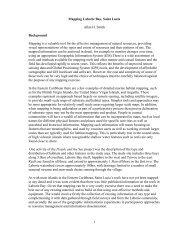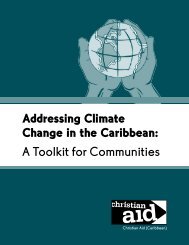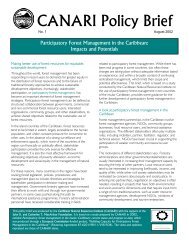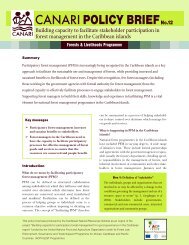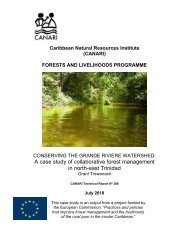The Caribbean Islands Biodiversity Hotspot Letter of ... - CANARI
The Caribbean Islands Biodiversity Hotspot Letter of ... - CANARI
The Caribbean Islands Biodiversity Hotspot Letter of ... - CANARI
You also want an ePaper? Increase the reach of your titles
YUMPU automatically turns print PDFs into web optimized ePapers that Google loves.
Project InformationProject Title – A good title should paint a quick picture for the reader <strong>of</strong> the keyidea(s) <strong>of</strong> your project, identify the strategic objectives and note which keybiodiversity area(s) - KBA(s) and country the project will focus on.Project Duration – Enter the approximate time period <strong>of</strong> your project and theproject’s expected start date. All projects must be completed by 30 September 2015,in line with the closing <strong>of</strong> the CEPF <strong>Caribbean</strong> <strong>Islands</strong> investment programme.Please note that the RIT will aim to grant successful applications within eight weeks<strong>of</strong> LOI submission, so please ensure your start date takes this into account.CEPF Region: <strong>Caribbean</strong> <strong>Islands</strong> <strong>Biodiversity</strong> <strong>Hotspot</strong>Project Location – Define the geographic location where project activities will takeplace (including country, corridor and KBA where relevant).<strong>The</strong> eligible sites are listed in the Ecosystem Pr<strong>of</strong>ile. Please see pages 90 -98.Country(s):Corridor(s):Key <strong>Biodiversity</strong> Area(s):Strategic Direction from the CEPF Ecosystem Pr<strong>of</strong>ile – Tick one single strategicdirection this proposal aims to address.<strong>The</strong> Strategic Directions are in the Ecosystem Pr<strong>of</strong>ile. If you believe your projectaddresses more than one strategic direction or investment priority, indicate the onesto which you feel your project makes the largest contribution.Please see pages 99 -105: You should add the investment priority number(s) (e.g.1.1, or / and 1.2 etc.)[ ] Strategic Direction 1 Investment Priority ( )[ ] Strategic Direction 2 Investment Priority ( )[ ] Strategic Direction 3 Investment Priority ( )4 | P a g e
<strong>Letter</strong> <strong>of</strong> InquiryPlease complete sections 1 to 8 below. <strong>The</strong> information you provide is s meant togive the RIT a clear understanding <strong>of</strong> your project concept and how you will go aboutimplementation.. <strong>The</strong> LOI is typically 4 – 8 pages long. <strong>The</strong> guidance notes for eachsection outline the type <strong>of</strong> information required. :1. Project Rationale – (One page at maximum)Identify what is (are) the conservation problem(s) or need(s) in the area that theproject will attempt to address. Describe what would happen if this project was notimplemented. This section should at least answer the following questions:1. What are the current threats / challenges / problems / needs that you areattempting to address or improve by doing the project?2. What have been the main past interventions (if any)?3. What makes this project unique and different from other projects thatattempted to address the same issue?2. Description <strong>of</strong> Project Site(s) / Location(s) – (One page at maximum)Provide a brief description <strong>of</strong> the site(s) including the location, ecological importance,and the social and economic context (try to include a map, if possible).3. Project Goal, Activities and Expected Results– (Three pages atmaximum)This section provides details on how you will address the needs identified.State the main goal <strong>of</strong> your project. <strong>The</strong> goal should be stated as the solution to theconservation problem/ need stated above.List the objectives <strong>of</strong> the project. Be as specific as possible, ensuring the objectivesare specific, measurable, attainable by the end <strong>of</strong> the project, relevant and timebound.State the expected results. <strong>The</strong>se are what you expect the project to achieve.<strong>The</strong>se should be arranged into outcomes and outputs. <strong>The</strong> project outcomes arethe direct short-term benefits produced by the actions. State possible benefits andwho will benefit.<strong>The</strong> project outputs are the tangible and measurable project deliverables. Forexample, one workshop, two training manuals. Please list all outputs which arerelevant to observe progress towards achieving the objectives.Describe the proposed project activities. <strong>The</strong> project activities are the actions takenor the work performed to achieve the project goal. Also, present your actions in theworkplan form attached to this LOI with an indicative timeframe.4. Project Potential Risks – (150 words)This section deals with planning for circumstances that can lead to not achieving yourproject goal which are outside <strong>of</strong> the control <strong>of</strong> the project.. This section should for5 | P a g e
example answer the following questions:Could l the project be affected by any social and/or economic risks (such ascrop prices being unstable, labour strikes, beneficiaries unwilling to try newtechniques, high turnover <strong>of</strong> project staff)?Could the project be affected by any environmental risks (such as no rainfalland its effect on the rain-fed crops, flooding, hurricane season)?Could the project be affected by any other risks including, but not limited to,political and financial risks (such as the economic crisis, civil unrest,government policies that are against your project idea)?If the answer was yes to any <strong>of</strong> the three above questions, please describethe type <strong>of</strong> risks involved in the project and the proposed measures to beundertaken to minimize potential adverse impacts.5. Project Partners / Stakeholders - (150 words)List all partners that will be directly involved in implementing this project and for eachone, describe their anticipated role. List key stakeholders and provide information onhow you have involved them in planning your project.6. Long-term Sustainability – (150 words)Describe how the results will contribute to conservation <strong>of</strong> biodiversity beyond the life<strong>of</strong> the project. It should address the sustainability <strong>of</strong> three different aspects -ecological, social and economic.7. Link to CEPF Investment Strategy – (150 words)How does your project relate to the CEPF investment strategy presented in theEcosystem Pr<strong>of</strong>ile? Your answer should include references to the specific StrategicDirection the project will support. Also refer to the logical framework on pages 107 –109 <strong>of</strong> the Ecosystem Pr<strong>of</strong>ile and indicate if your project will contribute to Outcomes1 – 3 and8. Work planUsing the actions identified in your LOI’s Project Goal, Activities and Results section,list the activities that you will need to undertake and highlight the month(s) you intendto implement them. Please adjust the table according to the number <strong>of</strong> proposedactivities as well as the proposed timeframe <strong>of</strong> the project. Refer to Appendix 1 for asample work plan.6 | P a g e
equipment/tools/cameras/safety equipment. Please indicate for each item, how many<strong>of</strong> each item is required and provide an estimated unit price.)Maintenance:(This is for maintenance <strong>of</strong> any equipment or vehicles you will use during the project).Travel:(This is for travel costs such as petrol (indicate mileage expected), boat rental, flights,etc.)Meetings & Events:(This is for stakeholder workshops, project events, etc. Please indicate the number <strong>of</strong>people attending and what the amount will cover (e.g. food/accommodation/localtransport costs for participants.)Miscellaneous:(Payments are made in US $ so please check if there will be bank charges related toyour bank account. If there are, please calculate them and include them in this line.Please try to include all other expenses where possible in the other budget lines.Note that CEPF cannot support general contingency expenses, but only specificbudget items.)Indirect Cost (max 13%):(This line is reserved for organizations with an approved United States <strong>of</strong> America,Federal Indirect Cost Rate. Organizations seeking to use this budget line to covercosts such as electricity, rent, etc, will have to provide documents to support thisdesignation. Please ensure it will only cover costs related to this project and is notduplicated in other budget lines.)Total Budget:(Please check the sub-totals from each budget line add up and include only the totalamount you are requesting for this CEPF grant)8 | P a g e
Eligibility<strong>The</strong> questions below help the RIT determine the eligibility <strong>of</strong> your organization orproposed project activities to receive CEPF funds. Where possible, you may reviseyour strategy to avoid these elements or you may wish to consult the “Resources”section at www.cepf.net that provides links to additional funding sources andresource sites. If you need further help we encourage you to seek guidance from theRIT at cepf-rit@canari.org.Ineligible Recipients <strong>of</strong> FundsGovernment agencies, and organizations controlled by government agencies, arenot eligible to receive CEPF funds.Do you represent, or is your organization controlled by, a government agency?[ ] Yes[ ] NoGovernment-owned enterprises or institutions are eligible only if they can establish (i)that the enterprise or institution has a legal personality independent <strong>of</strong> anygovernment agency or actor, (ii) that the enterprise or institution has the authority toapply for and receive private funds, and (iii) that the enterprise or institution may notassert a claim <strong>of</strong> sovereign immunity.If your organization is a government-owned enterprise or institution, can it clearlyestablish each <strong>of</strong> the three items named above?[ ] Yes[ ] NoIneligible Use <strong>of</strong> FundsCEPF will not fund the capitalization <strong>of</strong> trust funds, the purchase <strong>of</strong> land, theinvoluntary resettlement <strong>of</strong> people, or the removal or alteration <strong>of</strong> any physicalcultural property under any circumstances. Please answer “yes” or “no” to each item:Does your proposed activity intend to use CEPF grant money to capitalize a trustfund?[ ] Yes[ ] NoDoes your proposed activity intend to use CEPF grant money to purchase land?[ ] Yes[ ] NoDoes your proposed activity intend to use CEPF grant money to resettle people?[ ] Yes[ ] NoDoes your proposed activity intend to use CEPF grant money to remove or alter anyphysical cultural property (defined as movable or immovable objects, sites,structures, and natural features and landscapes that have archeological,paleontological, historical, architectural, religious, aesthetic, or other cultural9 | P a g e
significance)?[ ] Yes[ ] NoSafeguard Policy AspectsIf the answer to one or more <strong>of</strong> the following questions is marked Yes, pleasesummarize the potential impacts and how these might be avoided or mitigated.Please be aware that the RIT may ask applicants for additional information andproject documentation if the project possesses the potential to trigger SafeguardPolicies. For more information about the Safeguard Policy Aspects please check thefollowing: http://www.cepf.net/grants/Pages/safeguard_policies.aspxEnvironmental assessment:Will the project have adverse impacts on the environment? If you answer yes,please provide additional information and a description <strong>of</strong> mitigating measures youwill take.[ ] Yes[ ] NoNatural habitats and forests:Will the project cause or facilitate any significant loss or degradation <strong>of</strong> forests orother natural habitats? If you answer yes, please provide additional information anda description <strong>of</strong> mitigating measures you will take.[ ] Yes[ ] NoInvoluntary restrictions <strong>of</strong> access to resources:Will the project introduce or strengthen involuntary restrictions <strong>of</strong> access toresources? If you answer yes, please provide additional information and adescription <strong>of</strong> mitigating measures you will take.[ ] Yes[ ] NoIndigenous peoples:Does the project plan to work in lands or territories traditionally owned, customarilyused, or occupied by indigenous peoples? If you answer yes, please provide a briefdescription <strong>of</strong> planned activities in these lands or territories, any adverse impactsforeseen on these indigenous peoples an d any mitigating measures you will take.[ ] Yes[ ] NoPest management:Will the project involve use <strong>of</strong> herbicides, pesticides, insecticides or any other poisonfor the removal <strong>of</strong> invasive species? If you answer yes, please provide the name <strong>of</strong>the pesticide, herbicide, insecticide or poison you intend to use.[ ] Yes[ ] No10 | P a g e
Appendix 1 - Workplan exampleWorkplanUsing the actions identified in your LOI’s Project Goal, Activities and Results section, list the activities that you will need to undertake andhighlight the month(s) you intend to implement them. Please adjust the table according to the number <strong>of</strong> proposed activities as well as theproposed timeframe <strong>of</strong> the project.Description <strong>of</strong> ActivitiesActivity 1: Field data collectionActivity 2: Analysis <strong>of</strong> field dataActivity 3: Workshop planningActivity 4: WorkshopActivity 5: ReportingActivity 6:Activity 7:Activity 8:Activity 9:Activity 10:Project Duration (months)1 2 3 4 5 6 7 8 9 10 11 1211 | P a g e
Appendix 2 - Budget exampleBudgetFunding Request Amount – Enter the amount <strong>of</strong> funds (in US $) requested fromCEPF.US$ 19,220Total Project Budget –Enter the total budget for this project from all fundingsources.US$ 29,470Counterpart Funding – Identify the amounts and sources <strong>of</strong> any other fundingalready secured to be directed to this project.GEF small grant US$ 3500In-Kind Contributions – Enter the amount <strong>of</strong> your organization’s contributions orpartner organization's contributions are to be directed to this project and explain howthese have been calculated.Salary for Project Manager at US$250.00/ month for 9 months- $2,250.00Facilitation <strong>of</strong> the Public Awareness Campaign US$500.00Financial Management <strong>of</strong> the Project US$1,000.00 Project Accounts US$500.00 Project Record Keeping $US500.00General Administrative Costs <strong>of</strong> the Project US$3,000.00Personnel at US$150/month for 9 months- US$2,850.00Materials and Supplies including stationary materials and meeting refreshments atUS$1,500Total In-Kind Contribution: US$6,750.00Provide a breakdown <strong>of</strong> the proposed project budget using the following categories(in US $ and only for the CEPF funded portion <strong>of</strong> the project). Your budget mustrelate to the activities in your proposed project. Please explain how your budget wascalculated in the boxes below or attach your workings to help the RIT understandhow it relates to your project plan. We ask applicants to submit figures based onrecent quotes and to be as accurate as possible, ideally to the nearest $100.Ensure all budget lines ONLY cover costs related to this project and that are notalready included in the Indirect Cost line.Salaries/Benefits:(This is for people employed by your organization. Please indicate names, their jobdesignation, the rate to be paid and what activity they will be involved in.)John Brown, Technical Officer , @ US$200 per month for 5 months for projectmanagement 1000Pr<strong>of</strong>essional Services:(This is for services you will pay for, such as a consultant, workshop presenter,printing services, etc. Please indicate the rate <strong>of</strong> pay for each service listed).12 | P a g e
Stipend for 2 persons to create a video documentary on the history, culture andconservation <strong>of</strong> the area @ US$200 per month for 2 months 800Stipend for facilitator <strong>of</strong> workshops for 2 months @ US400 per month 800Stipend for editing and final production <strong>of</strong> video at US$200 200TOTAL = 1800Rent/Storage/Utilities:(This is for the rent <strong>of</strong> workshop/laboratory/<strong>of</strong>fice space, storage space for supplies orequipment, and utilities such as electricity/water. Please indicate what project activityit relates to).Rent for workshops for 2 months @ US$250 per month 500Telecommunications:(Please indicate what project activity it relates to e.g. for a mobile phone please statewho will be using it, why it is needed and calculate costs as accurately as possible).Mobile phone to be used for mobilisation for workshops by Project manager for 2months @ US$20 per month 40Postage and Delivery:(Please indicate what project activity it relates to).Dissemination <strong>of</strong> workshop report and outputs 300Supplies:(Supplies are items such as stationery, paper, printer ink, seedlings, etc. needed toexecute project activities. Please indicate for each item, how many <strong>of</strong> each item isrequired and provide an estimated unit price.)200 seedlings 20020 Kg Fertiliser 100Stationery for workshops 800TOTAL = 1100Furniture and Equipment:(This is for furniture if you require <strong>of</strong>fice furniture, or equipment such as fieldequipment/tools/cameras/safety equipment. Please indicate for each item, how many<strong>of</strong> each item is required and provide an estimated unit price.)Equipment for the clearing and demarcation <strong>of</strong> the trail and reforestation 430Equipment rental <strong>of</strong> video camera for the video documentary at $100/month for twomonths 200Equipment rental <strong>of</strong> projector and flip chart board at $100/month for two months200Furniture for workshops - chairs and tables 800Total = 1430Maintenance:(This is for maintenance <strong>of</strong> any equipment or vehicles you will use during the project).Travel:(This is for travel costs such as petrol (indicate mileage expected), boat rental, flights,13 | P a g e
etc.)Travel for 12 persons to demarate the trail / reforest the land for a total <strong>of</strong> 40 days atUS$20 per day 9,600Meetings & Events:(This is for stakeholder workshops, project events, etc. Please indicate the number <strong>of</strong>people attending and what the amount will cover (e.g. food/accommodation/localtransport costs for participants.)Meals for workshops (25 persons at 35 US$ for 3 days) 2625Local transportation cost for participants (25 persons @ 10 US$ for 3 days) 750Total = 3375Miscellaneous:(Payments are made in US $ so please check if there will be bank charges related toyour bank account. If there are, please calculate them and include them in this line.Please try to include all other expenses where possible in the other budget lines.Note that CEPF cannot support general contingency expenses, but only specificbudget items.)Bank transfer (3@ 25 US$) for funds from CEPF 75Indirect Cost (max 13%):(This line is reserved for organizations with an approved United States <strong>of</strong> America,Federal Indirect Cost Rate. Organizations seeking to use this budget line to covercosts such as electricity, rent, etc, will have to provide documents to support thisdesignation. Please ensure it will only cover costs related to this project and is notduplicated in other budget lines.)Total Budget:(Please check the sub-totals from each budget line add up and include only the totalamount you are requesting for this CEPF grant)Total budget amount = 1922014 | P a g e


